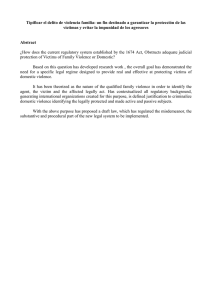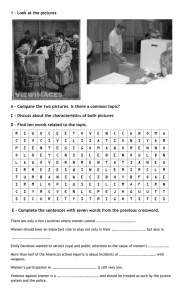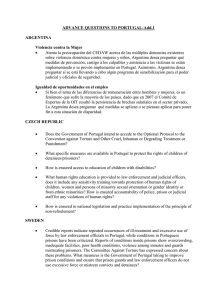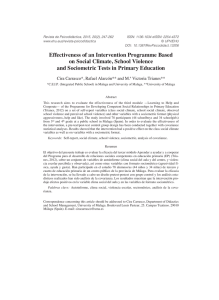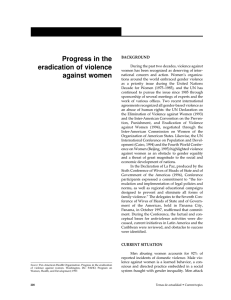Assessment of Distorted Thoughts about Women and Violence in
Anuncio
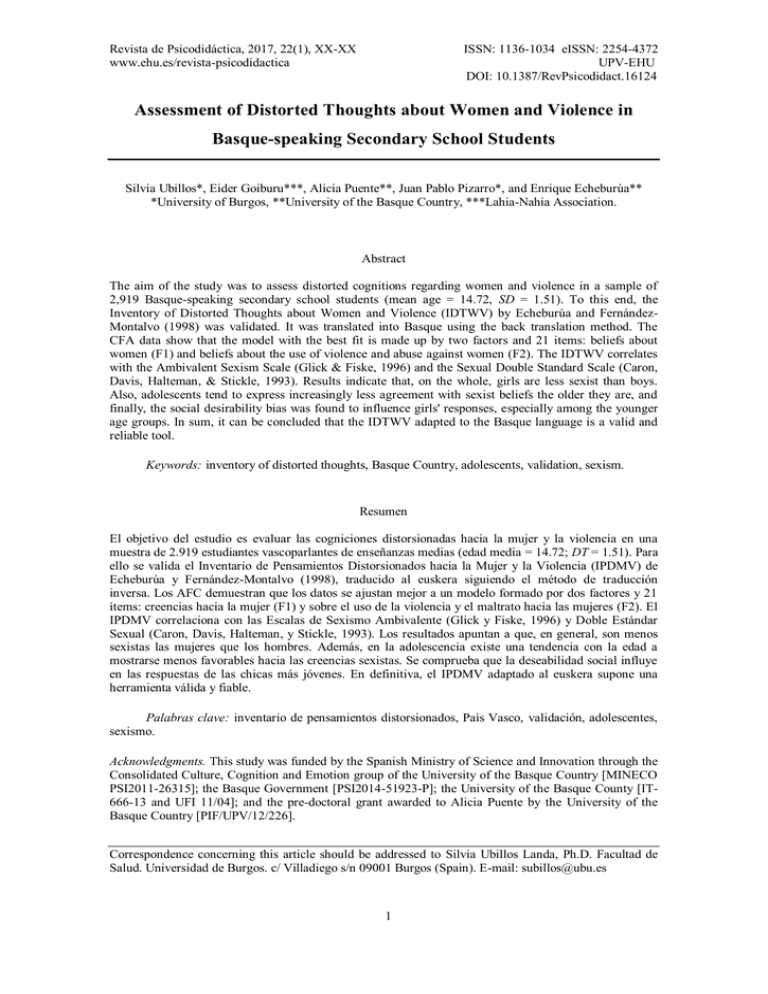
Revista de Psicodidáctica, 2017, 22(1), XX-XX www.ehu.es/revista-psicodidactica ISSN: 1136-1034 eISSN: 2254-4372 UPV-EHU DOI: 10.1387/RevPsicodidact.16124 Assessment of Distorted Thoughts about Women and Violence in Basque-speaking Secondary School Students Silvia Ubillos*, Eider Goiburu***, Alicia Puente**, Juan Pablo Pizarro*, and Enrique Echeburúa** *University of Burgos, **University of the Basque Country, ***Lahia-Nahia Association. Abstract The aim of the study was to assess distorted cognitions regarding women and violence in a sample of 2,919 Basque-speaking secondary school students (mean age = 14.72, SD = 1.51). To this end, the Inventory of Distorted Thoughts about Women and Violence (IDTWV) by Echeburúa and FernándezMontalvo (1998) was validated. It was translated into Basque using the back translation method. The CFA data show that the model with the best fit is made up by two factors and 21 items: beliefs about women (F1) and beliefs about the use of violence and abuse against women (F2). The IDTWV correlates with the Ambivalent Sexism Scale (Glick & Fiske, 1996) and the Sexual Double Standard Scale (Caron, Davis, Halteman, & Stickle, 1993). Results indicate that, on the whole, girls are less sexist than boys. Also, adolescents tend to express increasingly less agreement with sexist beliefs the older they are, and finally, the social desirability bias was found to influence girls' responses, especially among the younger age groups. In sum, it can be concluded that the IDTWV adapted to the Basque language is a valid and reliable tool. Keywords: inventory of distorted thoughts, Basque Country, adolescents, validation, sexism. Resumen El objetivo del estudio es evaluar las cogniciones distorsionadas hacia la mujer y la violencia en una muestra de 2.919 estudiantes vascoparlantes de enseñanzas medias (edad media = 14.72; DT = 1.51). Para ello se valida el Inventario de Pensamientos Distorsionados hacia la Mujer y la Violencia (IPDMV) de Echeburúa y Fernández-Montalvo (1998), traducido al euskera siguiendo el método de traducción inversa. Los AFC demuestran que los datos se ajustan mejor a un modelo formado por dos factores y 21 ítems: creencias hacia la mujer (F1) y sobre el uso de la violencia y el maltrato hacia las mujeres (F2). El IPDMV correlaciona con las Escalas de Sexismo Ambivalente (Glick y Fiske, 1996) y Doble Estándar Sexual (Caron, Davis, Halteman, y Stickle, 1993). Los resultados apuntan a que, en general, son menos sexistas las mujeres que los hombres. Además, en la adolescencia existe una tendencia con la edad a mostrarse menos favorables hacia las creencias sexistas. Se comprueba que la deseabilidad social influye en las respuestas de las chicas más jóvenes. En definitiva, el IPDMV adaptado al euskera supone una herramienta válida y fiable. Palabras clave: inventario de pensamientos distorsionados, País Vasco, validación, adolescentes, sexismo. Acknowledgments. This study was funded by the Spanish Ministry of Science and Innovation through the Consolidated Culture, Cognition and Emotion group of the University of the Basque Country [MINECO PSI2011-26315]; the Basque Government [PSI2014-51923-P]; the University of the Basque County [IT666-13 and UFI 11/04]; and the pre-doctoral grant awarded to Alicia Puente by the University of the Basque Country [PIF/UPV/12/226]. Correspondence concerning this article should be addressed to Silvia Ubillos Landa, Ph.D. Facultad de Salud. Universidad de Burgos. c/ Villadiego s/n 09001 Burgos (Spain). E-mail: [email protected] 1 2 SILVIA UBILLOS, EIDER GOIBURU, ALICIA PUENTE, JUAN-PABLO PIZARRO, AND ENRIQUE ECHEBURÚA Introduction Ambivalent sexism is considered one of the principal beliefs which contributes to maintaining inequality and perpetuating the imbalance of power between the sexes (Montañés, Megías, De Lemus, & Moya, 2015). It has a significant effect on women and is associated with a greater probability of becoming a victim of gender-based violence (Garaigordobil & Aliri, 2013). Numerous studies have shown the repercussion of sexism on women's lives and its association with the likelihood of them becoming victims of violence at some point (Nguyen et al., 2013). In Europe, one in three women over the age of 15 suffer some form of physical or sexual abuse, and 43% are victims of psychological violence (European Council, 2014). Sexism comprises various different components (Díaz-Aguado, 2006): (a) a cognitive component, which consists of confusing existing social or psychological differences between men and women with sex-related biological differences, in the erroneous belief that the former arise automatically and inevitably as a result of the latter; (b) an affective component, which is rooted in a sexist means of constructing one's identity and which explains the relationship between masculine identity and the violence perpetrated by men, as well as women's tendency to feel guilty and/or depressed; and (c) a behavioural component, which consists of the tendency to put sexist attitudes into practice through discrimination and violence. The Inventory of Distorted Thoughts about Women and Violence (IDTWV) is a measurement instrument which assesses the cognitive component of sexism and violence as a problem-solving strategy. It was originally designed by Echeburúa and Fernández-Montalvo (1998, 2009; Echeburúa, Amor, Sarasua, Zubizarreta, & HolgadoTello, 2016) for clinical practice, although without psychometric guarantees, as part of a cognitive-behavioural programme for treating abusers. Two studies have since validated this instrument with Spanish sample groups. Firstly, Ferrer, Bosch, Ramis, Torres and Navarro (2006) administered the IDTWV to 1,395 university students, after modifying the response system (from true-false to a 4point Likert-type scale). These authors also eliminated 5 items from the original scale and grouped the remaining items into 4 dimensions (D1: belief in women's inferiority to men; D2: blaming the female victims of abuse; D3; acceptance of violence as a valid means of solving problems; and D4: minimising the problem of violence against women and exculpating the abuser), with a Cronbach's Alpha of .84. The main limitation of this study was that the sample group was made up exclusively of university students, and almost two thirds were women. Recently, the inventory was validated once again (Loinaz, 2014) with 180 inmates convicted of intimate partner violence. Several items were eliminated due to either their low factor loadings, their scarce contribution to the consistency of the scale or the fact that their wording was confusing. The factor solution is similar to the one proposed by Ferrer et al. (2006), with an alpha of .76. This second study also had a number of limitations: the sample group was comprised exclusively of incarcerated abusers, with no control group, the social desirability bias was not controlled for and nor was the convergent validity established. The IDTWV is currently being used in a large number of studies with aggressors (Boira, López del Hoyo, Tomás-Aragonés, & Gaspar, 2013; Echeburúa, Sarasua, Zubizarreta, Amor, & de Corral, 2010; Fernández-Montalvo, Echauri, Martínez, & Azcárate, 2012; RodríguezEspartal, & López-Zafra, 2013). Revista de Psicodidáctica, 2017, 22(1), ##-## ASSESSMENT OF DISTORTED THOUGHTS ABOUT WOMEN AND VIOLENCE IN BASQUE-SPEAKING SECONDARY SCHOOL STUDENTS 3 Interventions aiming to redress cognitive distortions are related to gender-based violence prevention in educational contexts, particularly during adolescence, since this is a crucial stage in the socialisation and identity construction process (Díaz-Aguado & Carvajal, 2011). Classroom-based prevention has proven effective at both a national and international level (Fox, Hale, & Gadd, 2014; Garaigordobil & Martínez-Valderrey, 2014), precisely because of the changes induced on two fronts: gender stereotypes and justification of violence, which have been linked to suffering from or perpetrating gender-based violence (Anderson & Whiston, 2005, Garaigordobil & Aliri, 2011). In the Basque Country (Spain), violence towards women is increasing, with the number of victims reporting cases of gender-based violence rising from 1,711 in 2002 to 3,732 in 2014 (Saiz de Murieta, Olaizola, & Arrillaga, 2014). In 2013, 36% of victims and 28% of aggressors in the Basque Country were aged between 15 and 30 (Saiz de Murieta, et al., 2014). Given this context, the severe lack of instruments with psychometric guarantees for assessing justification of violence and gender stereotypes among Basque-speaking adolescents is striking. The aim of this present study was to assess distorted cognitions regarding women and violence among Basque-speaking adolescents. To this end, the psychometric properties of the Basque-language version of the IDTWV were validated in a sample of secondary school students. Method Participants The sample group comprised 2,919 adolescents from 25 different secondary schools (13 public and 12 private ones) in the Basque Country, Spain (1,578 girls and 1,341 boys). All participants were aged between 12 and 18 (M = 14.72; SD = 1.51). Given that the total secondary school population (1st year of secondary school to the last year of six-form college) in the Basque Country is 142,975 (Eustat, 2015), and assuming that the population variance for the worst-case p is 50% (hence q = 50%), then the permitted margin of error with a confidence interval of 95% of the sample is 1.80%. A non-probabilistic, quota-based sampling technique was used. Participants were recruited from schools which agreed voluntarily to take part in the study. The statistical criterion used for the quotas was a proportional selection from each stratum (type of school, school year and sex). Between fifteen and twenty-five students were randomly selected from each year group in each school. Instruments The Inventory of Distorted Thoughts about Women and Violence (IDTWV; Echeburúa & Fernández-Montalvo, 1998). This instrument comprises 29 items (13 about distorted views of women and 16 about violence) with a 4-point response scale (α = .84, Ferrer et al., 2006; α =.76, Loinaz, 2014). High scores indicate higher levels of distorted beliefs. The Basque version of the IDTWV was created by following the back translation method (Hambleton & Patsula, 1999). The Ambivalent Sexism Inventory (ASI; Glick & Fiske, 1996; Expósito, Moya, & Glick, 1998; Goiburu, 2016). This instrument comprises 22 items with a 5-point Revista de Psicodidáctica, 2017, 22(1), ##-## 4 SILVIA UBILLOS, EIDER GOIBURU, ALICIA PUENTE, JUAN-PABLO PIZARRO, AND ENRIQUE ECHEBURÚA response scale (1= strongly disagree, 5= strongly agree). High scores indicate a greater degree of ambivalent sexism. The inventory measures two types of sexism: Hostile Sexism (HS: 11 items, unidimensional) and Benevolent Sexism (BS: 11 items spread across three dimensions: protective paternalism, complementary gender differentiation and heterosexual intimacy). The internal consistency scores for the whole scale and the HS and BS sub-scales in the original version are .83, .80 and .77, and in the Spanish version.90, .89 and .86 respectively. In the Basque version, the Cronbach's alphas are also satisfactory (ASI = .85, HS = .83 and BS = .77). The composite reliability (omega coefficient) is .93 for HS and .91 for BS, and the total average variance extracted is .40 (Goiburu, 2016). The Double Standard Scale (DSS) (Caron, Davis, Halteman, & Stickle, 1993; Ubillos, Goiburu, Puente, & Pizarro, 2016). This instrument comprises 10 items with a 5-point Likert-type response scale (1 = strongly disagree, 5 = strongly agree). High scores indicate a greater degree of acceptance of the traditional sex-based double standard. The alpha reported in the original version was .72, with this figure being .68 in the Basque-language version. Short Form C of the Social Desirability Scale (SD) (Marlowe & Crowne; Reynolds, 1982; Ubillos et al., 2016). This instrument comprises 13 dichotomous (truefalse) items of the original 33. Higher scores indicate a greater degree of SD. The internal consistency of the scale is .68. Procedure The study design was cross-sectional, descriptive and correlational. Firstly, schools were contacted over the telephone in order to explain the purposes of the research project. Those that agreed to participate were selected by means of a quotabased statistical criterion. Next, a meeting was held with the managers to explain the project in more detail. Students were selected on a quota basis according to year group and sex. Parents' informed consent was then requested and collected. Finally, a team of 4 psychology graduates with specialist knowledge of equality issues administered the scales during class time in a session lasting approximately 30 minutes. The study complies with established ethical criteria for research involving human beings. Data analysis The answers provided by participants who failed to respond to more than 10% of the items in any one of the scales were discarded. Of all remaining respondents, 99.1% (n = 2,890) provided a full data set, and the maximum likelihood method was used to estimate missing data (Jamshidian & Bentler, 1998). An analysis was conducted of the homogeneity of the items based on the total items-scale correlation (< .30) (Morales, Urosa, & Blanco, 2003). The structure of the IDTWV was verified through confirmatory factor analyses (CFA), using the maximum likelihood method with the Mplus 7.1 program. The scaled chi-squared test was applied with the Satorra-Bentler adjustment (χ2–SB, Satorra & Bentler, 1994), based on the robust standard estimator. The goodness of fit of the data was determined by using the CFI (Comparative Fit Index) as the incremental fit index and the RMSEA (Root Mean Square Error Approximation) and SRMR (Standardised Root Mean Square Residual) as absolute fit indexes. The lower the values of χ2, AIC, Revista de Psicodidáctica, 2017, 22(1), ##-## ASSESSMENT OF DISTORTED THOUGHTS ABOUT WOMEN AND VIOLENCE IN BASQUE-SPEAKING SECONDARY SCHOOL STUDENTS 5 SRMR (< .08) and RMSEA (< .06), and the higher the values of the CFI and TLI (> .90) the better the model fits the data. A confidence interval of 90% was also included, provided by the RMSEA (Hu & Bentler, 1999). In addition to the internal consistency obtained using Cronbach's alpha, the Omega indexes (ω) were also calculated along with the average variance extracted (AVE), with indexes of over .50 being considered adequate for scales comprising more than two factors (Reise, Bonifay, & Haviland, 2013). The OMEGA program (Watkins, 2013) was used for this purpose. The convergent validity was calculated using Pearson correlations between the IDTWV, the ASI and the DSS. Sex differences were analysed using ANOVAs, showing the effect sizes (Hedges' g). The possible influence of the social desirability bias on the responses provided was measured using a correlation analysis (discriminant validity). Finally, a differential analysis was conducted of the items (DIF) to determine their uniformity in accordance with sex (Hidalgo, Gómez, & Padilla, 2005). Results Homogeneity analysis As in the validation carried out by Ferrer et al. (2006), items 19 (.21), 27 (.09), 28 (-.03) and 29 (.13) were found not to be homogeneous (< .30). In accordance with the model proposed by Loinaz (2014), in addition to the items listed above, item 7 (.28) also failed to show adequate homogeneity indexes. Moreover, in this study, items 21 (.25), 25 (.23) and 26 (.27) did not correlate over .30. Unlike the two previous models, item 8 was found to have values of > .30. Construct validity Firstly, the 4-factor, 24-item model proposed by Ferrer et al. (2006) was tested (eliminating items 8, 19, 27, 28 and 29). The second model analysed followed the structure proposed by Loinaz (2014), consisting of 4 dimensions and 24 items (eliminating items 7, 8, 19, 27 and 28). The data show that the goodness of fit indexes were not adequate for either Model 1 or Model 2 (Table 1). Table 1 Goodness of Fit Measurements of the Confirmatory Factor Analyses Model 1. Ferrer et al.'s model (2006) 2. Loinaz's model (2014) S-B χ 2 2429.732 Df 269 AIC 163089.591 .88 TLI .86 SRMR .053 RMSEA .052 90% CI .051-.054 2490.231 246 156173.356 .86 .85 .056 .057 .054-.058 3. 4-factor model 1377.759 183 133451.165 .92 .91 .041 .047 .045- .050 4. 2-factor model 1256.099 188 133319.506 .93 .92 .038 .044 .042- .046 CFI Revista de Psicodidáctica, 2017, 22(1), ##-## 6 SILVIA UBILLOS, EIDER GOIBURU, ALICIA PUENTE, JUAN-PABLO PIZARRO, AND ENRIQUE ECHEBURÚA Next, the modified 4-factor model proposed by Ferrer et al. (2006) was tested (excluding those items that were found not to be homogeneous in this study, namely items 7, 19, 21, 25, 26, 27, 28 and 29) (model 3). The resulting scale was reduced to 21 items. The indexes of fit were acceptable and the change in the chi-squared value was significant in comparison with model 1 (∆χ2(269) = 1893.732, p < .001). Nevertheless, the modification indexes (MI) showed that the fit was even better if item 9 (MI = 223.854) of D4 ("acceptance of traditional stereotypes and misogyny") was included in D2 ("blaming female victims of abuse"). Moreover, the correlations between three of the factors were very high (between .99 and .88). They were therefore merged into a single factor (Model 4). The final model therefore comprised 2 factors and 21 items: one factor referred to stereotyped beliefs about women (F1) and beliefs about violence that correspond to blaming women, and the other referred to accepting violence and exculpating the aggressor (F2) (Figures 1 and 2). Moreover, the chisquared comparison test indicated an improvement in model 4 in relation to models 1 (∆χ2(258)=1137.116, p < .001) and 2 (∆χ2(251) =1277.197, p < .001). The data obtained from the CFA revealed good fit indexes. Moreover, the correlation between the two factors was lower in comparison with the 4-factor model. The modification indexes did not suggest any further changes. The goodness of fit of the complete model with just boys was very similar to that obtained with the whole sample group. In the case of girls, the fit indexes were worse, although still adequate. The correlation between F1 and F2 was .68 (p = .0001) for girls and .73 (p = .0001) for boys. e1 e2 e3 e4 e5 e6 .57 .47 .36 .43 .41 .43 .68 It1 It2 It3 It4 It5 It6 It9 .66 .73 .80 .75 .77 .75 e8 e7 e9 .80 .61 e10 e11 e12 e13 e14 e15 e16 e17 e18 e19 e20 e21 .88 .86 .85 .77 .63 .66 .83 .88 .88 .86 .84 .85 It15 It14 It17 It22 It10 It11 It13 It16 It20 It23 It24 .56 .45 Misogyny .63 .34 .38 .39 .48 .61 .66 .73 It8 .75 .80 .39 Minimisation Blaming .88 .70 .67 Figure 1. Diagram of the four-factor model of the IDTWV. Revista de Psicodidáctica, 2017, 22(1), ##-## .49 It18 .37 Acceptance .92 .99 .73 It12 ASSESSMENT OF DISTORTED THOUGHTS ABOUT WOMEN AND VIOLENCE IN BASQUE-SPEAKING SECONDARY SCHOOL STUDENTS e1 e2 e3 e4 e5 e6 .57 .47 .35 .43 .41 .43 It1 It2 It3 It4 It5 It6 e7 .61 It9 e8 .80 .73 .81 .76 .77 .61 e10 .89 e11 .87 e12 .85 e13 e14 e15 e16 e17 e18 e19 e20 e21 .78 .64 .72 .87 .91 .89 .84 .86 .88 It22 It8 It12 It18 It10 It11 It13 It16 It20 It23 It24 .63 .66 e9 .45 .63 .33 .36 .39 7 .47 .60 It15 .53 It14 .36 It17 .30 .32 .40 .38 .35 .75 Blaming women, Accepting violence and exculpating the aggressor Misogyny .74 Figure 2. Diagram of the two-factor model of the IDTWV. Internal consistency The scale's internal consistency was high (α = .85), similar to that reported in the study by Ferrer et al. (2006) and higher than that reported by Loinaz (2014). In the fourfactor model (Model 3), the reliability of D1 “stereotyping and misogyny" was high (α = .88), that of D2 “blaming the victim” (α = .66) was acceptable and that of D3 “accepting violence” (α = .48) and D4 “minimising the importance of violence against women” (α = .34) was low. Nevertheless, the reliability indexes of the two-factor model (model 4) revealed that both F1 (α = .88) and F2 (α = .78) had a high level of internal consistency. The item-total correlation was higher than .30 in all cases. The composite reliability indexes showed a ω = .88 with an AVE of .53 for F1, and a ω = .78 with an AVE of .47 for F2. Convergent validity The results reveal that the scores obtained in the IDTWV are significantly associated with those obtained both in the ASI and its sub-scales and in the DSS. Moreover, since the IDTWV corresponds to traditional measures of sexism, the data indicate that this correlation is closer with the HS sub-scale than with the BS sub-scale of the ASI. Revista de Psicodidáctica, 2017, 22(1), ##-## 8 SILVIA UBILLOS, EIDER GOIBURU, ALICIA PUENTE, JUAN-PABLO PIZARRO, AND ENRIQUE ECHEBURÚA Table 2 Correlations between the IDTWV and the ASI and DSS IDTWV F1 IDTWV F2 IDTWV .453*** .374*** .440*** HS .464*** .391*** .429*** BS .327*** .243*** .318*** F1 BS .261*** .185*** .258*** *** *** F2 BS .166 .079 .184*** *** *** F3 BS .301 .256 .276*** *** *** DSS .454 .401 .409*** *** Note. p ≤ .001; F1 IDTWV = Traditional stereotypes and misogyny; F2 IDTWV = Acceptance of Abuse against Women and Legitimisation of Violence as an Educational Strategy; F1 BS = Protective Paternalism; F2 BS = Complementary Gender Differentiation; F3 BS = Heterosexual Intimacy; DSS = Double Sexual Standard. total ASI Associations between the IDTWV and sex and age The results reveal a main effect of sex on the total score obtained in the IDTWV, as well as on the scores obtained in F1 and F2 (Table 3). Boys scored higher than girls in all dimensions. The results also confirm significant differences between boys and girls in the IDTWV, in F1 and F2, and in all age groups. In all cases, the effect size was medium to large (g > 0.5) (Hedges & Olkin, 1985). Both boys [t(1340) = -33.181; p = .0001] and girls [t(1577) = -58.646; p = .0001] evinced more agreement with beliefs about abuse of women and the legitimisation of violence as an educational tool (F2) than with sexist beliefs about women (F1). Moreover, the analyses of variance revealed significant main effects in accordance with age group, both for the IDTWV, F(2, 2916) = 56.52; p = .0001, η2 = .037, and for F1, F(2, 2916) = 35.295; p = .0001, η2 = .024, and F2, F(2, 2916) = 54,567; p = .0001, η2 = .036. The post-hoc analyses indicated significant differences in the means obtained by the different age groups for the IDTWV and both its factors (p ≤ .050), with the exception of F1 in the 12-13 and 14-15 age groups. The evolution of sexism for each sex throughout the course of adolescence (intra-group differences) confirmed these results (p = .0001). The post-hoc analyses revealed differences in all age ranges and for both sexes (p ≤ .050), with the exception of the IDTWV and F2 for girls aged between 12-13 and 14-15, and F1 for both sexes between the ages of 12-13 and 14-15. Thus, older adolescents were more critical of favourable attitudes towards sexism and violence than their younger counterparts. Revista de Psicodidáctica, 2017, 22(1), ##-## ASSESSMENT OF DISTORTED THOUGHTS ABOUT WOMEN AND VIOLENCE IN BASQUE-SPEAKING SECONDARY SCHOOL STUDENTS 9 Table 3 Mean Scores in the IDTWV and its Factors in Accordance with Sex and Age total IDTWV Boys M SD 2.05 .46 F G 100.31*** 12-13 SD 1.68 .65 .70 105,104*** g F2 IDTWV M SD 2.20 .46 .81 1.76 .37 1.27 .45 1.95 .39 Total 1.89 .44 1.46 .59 2.07 .44 Boys 1.95 .46 1.65 .63 2.07 .46 .69 89.53*** .77 Girls 1.73 .38 1.32 .50 1.90 .41 Total 1.84 .43 1.49 .59 1.99 .44 Boys 1.82 .43 1.48 .55 1.95 .44 88,530*** 16-18 M F Girls 69,653*** 14-15 F1 IDTWV .72 140.15*** .79 Girls 1.62 .35 1.17 .34 1.80 .35 Total 1.70 .37 1.30 .47 1.86 .40 Boys 1.93 .46 1.60 .61 2.07 .47 Total sample 259.87*** .72 336.56*** .75 Girls 1.69 .35 1.24 .43 1.87 .38 Total 1.80 .42 1.41 .55 1.96 .43 group ***p ≤ .001. Revista de Psicodidáctica, 2017, 22(1), ##-## F g 68.63*** .50 39.92*** .56 44.55*** .58 152.57 .68 10 SILVIA UBILLOS, EIDER GOIBURU, ALICIA PUENTE, JUAN-PABLO PIZARRO, AND ENRIQUE ECHEBURÚA Discriminant validity A subsample made up of 809 adolescents (383 boys and 426 girls) with a mean age of 14.15 (SD = 1.39) was selected randomly from each of the schools participating in the study and asked to respond to the Short Form C of the Social Desirability Scale. This was done in response to a suspicion that the inventory might not necessarily be reflecting participants' true opinions, since responses to the IDTWV may be susceptible to the social desirably bias. The correlations between the SDS and the total score, F1 and F2 of the IDTWV were low yet significant (total score, r(809)=.147, p = .0001, F1, r(809) = .140, p = .0001 and F2, r(809)= .130, p = .0001). This same pattern of results was found also among girls: IDTWV, r(426) = .216, p = .0001, F1, r(426) = .253, p = .0001, and F2, r(426) = .175, p = .0001. An analysis in accordance with age group confirmed that these correlations were significant among girls aged between 12 and 15 (p < .050), but not among girls aged between 16 and 18. Among boys, however, SDS correlations were not significant. Differential functioning of the IDTWV items in accordance with sex The differential item functioning (DIF) analysis was conducted by means of binary logistic regression (LR) for each of the dimensions of the IDTWV. The items were dichotomised, with categories 1 (strongly disagree) and 2 (disagree) being recoded into category 0, and categories 3 (agree) and 4 (strongly agree) being recoded into category 1. The values obtained using the Wald test revealed that in F1, items 1-2-3 and 6 had DIF. In relation to F2, 5 items were found not to be uniform (11-13-15-17-18). This indicates a difference between the levels of agreement between boys and girls in those items with a non-uniform DIF (Table 4). Table 4 Wald Values and Significance Levels of the IDTWV Items in Accordance with Sex Item num. τ2 p – value τ3 p – value Stereotyping and Misogyny 1 3.23 .07 4.38 .04 2 6.48 .01 5.69 .02 3 5.16 .02 6.13 .01 4 1.79 .18 1.80 .18 5 19.59 .00 2.79 .09 6 3.43 .00 6.74 .01 Acceptance of Abuse against Women and Legitimisation of Violence as an Educational Strategy 8 1.16 .28 .06 .81 9 .93 .34 .01 .94 10 .25 .62 1.56 .21 11 9.17 .00 4.45 .04 12 .68 .40 1.06 .30 13 .07 .79 4.97 .03 14 9.53 .00 .34 .56 15 5.82 .02 5.93 .02 Revista de Psicodidáctica, 2017, 22(1), ##-## ASSESSMENT OF DISTORTED THOUGHTS ABOUT WOMEN AND VIOLENCE IN BASQUE-SPEAKING SECONDARY SCHOOL STUDENTS 16 17 18 20 22 23 24 .22 3.25 5.96 .92 3.78 3.97 3.07 .63 .07 .01 .34 .05 .05 .08 1.65 5.14 5.04 .48 1.58 1.37 .15 11 .20 .02 .03 .49 .21 .24 .7 Discussion This study analyses the psychometric properties of the IDTWV in Basquespeaking secondary school students, with the aim of providing an instrument that enables reliable diagnoses of negative beliefs about women and violence. Detecting the specific cognitive bias helps establish preventive strategies in the educational field (Fox et al., 2014). Gender-related power inequality in intimate relationships, gender rules and the normative use of violence in conflicts are all linked to intimate partner violence and are conceptualised as necessary "causes" (De Koker, Mathews, Zuch, Bastien, & Mason-Jones, 2014). Previous studies have drawn attention to the important risk factor posed by exposure to violent behaviour and attitudes during early romantic relationships in relation to suffering violence at the hands of one's partner later on in life (Muñoz, Ortega, & Sánchez, 2013). Thus, interventions should focus on adolescents in order to break the cycles of violence and victimisation that might otherwise be perpetuated during adulthood (De Koker et al., 2014). A series of elements linked to psycho-evolutionary development during adolescence, such as the search for autonomy, the importance of peer relations and the awakening of sexual attraction, make this a particularly crucial period for providing educational opportunities aimed at fostering peaceful conflict resolution within intimate partner relationships (Muñoz et al., 2013). In this sense, education is a priority strategy for transforming the attitudes and behaviours of young generations, since at this age the violent and abusive relational dynamic has yet to be consolidated (Díaz de Greñu-Domingo & ParejoLlanos, 2013). In relation to the IDTWV, the analyses attest to the validity and reliability of the Basque-language version. The structure which best fits the data comprises two factors and is fairly similar to the authors' theoretical proposal (Echeburúa & FernándezMontalvo, 1998). The first factor refers to a stereotyped vision of women and misogyny, while the second measures beliefs regarding abuse against women and the use of violence as an educational resource and problem-solving strategy. The main difference between our model and Echeburúa and Fernández-Montalvo's one (1998) is that all the items in the original factor 1 which refer to gender-based violence (e.g. item 11 "Many women deliberately provoke their husbands into losing control and hitting them), are included in factor 2 of the Basque version. The positive correlations between the two factors suggest that stereotypes and misogyny function at a cultural level as ideologies which justify and maintain abuse against women and the use of violence. The correlations between the IDTWV and its dimensions with the ASI and the DSS provide evidence of the scale's convergent validity. As expected, the correlations observed between the IDTWV and HS are stronger than between the inventory and BS Revista de Psicodidáctica, 2017, 22(1), ##-## 12 SILVIA UBILLOS, EIDER GOIBURU, ALICIA PUENTE, JUAN-PABLO PIZARRO AND ENRIQUE ECHEBURÚA (Peixoto, 2010). This is consistent with the fact that the IDTWV evaluates manifestly sexist beliefs and beliefs about violence against women. The sex-related differences found in the scores obtained in the IDTWV are similar to those reported by recent studies (Ferrer, Bosch, Ramis, & Navarro, 2006; MarquesFagundes, Megías, García-García, & Petkanopoulou, 2015). Since sexist beliefs imply acceptance of violence, the blaming of victims, the minimisation of the problem and the exoneration of aggressor, it is logical to expect boys to score higher than girls (Lameiras & Rodríguez, 2002). Our results confirm the existence of a tendency among adolescents to evince a less favourable attitude to sexist beliefs as they grow older, although sex differences still remain, with girls being, in general, less sexist than boys. Other studies carried out in Spain with young people have found that older adolescents are more aware of the negative meaning of sexism and the use violence against women in today's society (Lameiras & Rodríguez, 2002). The social desirability bias was only found to influence girls' responses, with this effect being particularly strong among younger girls (aged 12 to 15). In this sense, Pérez, Labiano and Brusasca (2010) argue that girls have a stronger need for others' approval than boys. Consequently, girls try to adapt their responses to reflect the social norms of femininity, even when these differ from their personal beliefs. Montañes et al. (2015) argue that during the early years of adolescence, and in adolescent contexts in which male leadership is strong, girls are more heavily influenced by the social desirability bias and tend to give more sexist responses in order to conform to the dominant masculine social ideal. Furthermore, Sastre and Moreno (2002) highlight the importance of the informal culture, since peers are agents of gender socialisation. This is confirmed by the results of our study, in which younger girls were more influenced by the social desirability bias and responded in accordance with the male norms of their peer group. From a gender perspective, the result confirms the influence of the patriarchal system based on male control over women (Aranda, Montes-Berges, & Castillo-Mayén, 2015). Moreover, it also indicates that the young adolescent girls in our study perceive the culture in which they are immersed as being tolerant towards certain levels of sexism. As regards DIF, many items (over 40%) were found to be non-uniform as regards sex. Gierl, Gotzmann and Boughton (2004) point out that in cases of test translation and adaptation, the percentage of DIF items is usually higher than 20%. The dimension with the greatest number of DIF items was the stereotyping and misogyny factor. These differences may either be a legitimate part of the construct or be due to other variables that are not relevant within it (Hidalgo, Galindo, Inglés, Campoy, & Ortiz, 1999). Thus, the social desirability bias may be a factor which explains the high number of DIF items. If this hypothesis is correct, once both the ability being measured by the items and the social desirability bias are equalled, the DIF should either disappear or, at least, be attenuated. When this strategy was applied, the data revealed that only item 3 still had DIF. It is therefore plausible that the social desirability bias was the underlying cause of the DIF detected. This study has a number of limitations that should be taken into account. Firstly, since the sample group was not selected in accordance with a probabilistic or random criterion, we should be cautious when generalising the results obtained. Secondly, although it is possible that the factors which may influence the social desirability bias include the norms of femininity and the influence of the peer group during adolescence, Revista de Psicodidáctica, 2017, 22(1), ##-## ASSESSMENT OF DISTORTED THOUGHTS ABOUT WOMEN AND VIOLENCE IN BASQUE-SPEAKING SECONDARY SCHOOL STUDENTS 13 along with male domination, these factors require further research and study. It would also be interesting to determine whether or not this phenomenon only occurs when these particular types of belief are measured, or whether it also affects the measurement of other areas. In sum, despite these limitations, we can conclude that the Basque-language version of the IDTWV offers sufficient guarantees to adequately detect and evaluate beliefs regarding women and violence. References Anderson, L. A., & Whiston, S. C. (2005). Sexual assault education programs: metaanalytic examination of their effectiveness. Psychology of Women Quarterly, 29(4), 374-388. doi: 10.1111/j.1471-6402.2005.00237.x Aranda, M., Montes-Berges, B., & Castillo-Mayén, M. R. (2015). The social dominance orientation in adolescence: the role of gender identity and stereotypical male and female traits. Revista de Psicología Social, 30(2), 241-263. doi: 10.1080/21711976.2015.1016752 Boira, S., López del Hoyo, Y., Tomás-Aragonés, L., & Gaspar, A. R. (2013). Intervención psicológica en la comunidad en hombres condenados por violencia de género. Anales de Psicología, 29(1), 19-28. Caron, S. L., Davis, C. M., Halteman, W. A., & Stickle, M. (1993). Predictors of condom related behaviours among first year college students. Journal of Sex Research, 30(3), 252-259. doi: 10.1080/00224499309551709 Council of Europe (2014). Violence against women: an EU-wide survey. Main results. Luxembourg: Publications Office of the European Union. De Koker, P., Mathews, C., Zuch, M., Bastien, S., & Mason-Jones, A. J. (2014). A systematic review of interventions for preventing adolescent intimate partner violence. Journal of Adolescent Health, 54(1), 3-13. doi: 10.1016/j.jadohealth.2013.08.008 Díaz de Greñu-Domingo, S., & Parejo-Llanos, J. L. (2013). La promoción de la igualdad y el respeto de la diversidad afectivo-sexual: bases de un programa de orientación y tutoría para educación secundaria. Revista Española de Orientación y Psicopedagogía, 24(3), 63-79. doi: 10.5944/reop.vol.24.num.3.2013.11245 Díaz-Aguado, M. J. (2006). Sexismo, violencia de género y acoso escolar. Propuestas para una prevención integral de la violencia. Revista de Estudios de Juventud, 73, 38-57. Díaz-Aguado, M. J., & Carvajal, I. (2011). Igualdad y prevención de la violencia de género en la adolescencia y la Juventud. Madrid: Ministerio de Sanidad, Igualdad y Servicios Sociales. Echeburúa, E., Amor, P. J., Sarasua, B., Zubizarreta, I., & Holgado-Tello, F. P. (2016). Inventario de Pensamientos Distorsionados sobre la Mujer y el Uso de la Violencia-Revisado (IPDMUV-R): propiedades psicométricas. Anales de Psicología, 32(3), 837-846. doi: 10.6018/analesps.32.3.231901 Echeburúa, E., Sarasua, B., Zubizarreta, I., Amor, P. J., & Corral, P. (2010). Variables predictoras del rechazo, abandono y fracaso terapéutico en hombres violentos contra su pareja tratados psicológicamente en un marco comunitario. International Journal of Clinical and Health Psychology, 10(3), 403-420. Revista de Psicodidáctica, 2017, 22(1), ##-## 14 SILVIA UBILLOS, EIDER GOIBURU, ALICIA PUENTE, JUAN-PABLO PIZARRO AND ENRIQUE ECHEBURÚA Echeburúa, E., & Fernández-Montalvo, J. (1998). Hombres maltratadores. In E. Echeburúa y P. Corral (Eds.), Manual de violencia familiar (pp. 71-175). Madrid: Siglo XXI. Echeburúa, E., & Fernández-Montalvo, J. (2009). Evaluación de un programa de tratamiento en prisión de hombres condenados por violencia grave contra la pareja. International Journal of Clinical and Health Psychology, 9(1), 5-20. Eustat (2015). Alumnado de enseñanzas de régimen general y educación de personas adultas en la C.A. de Euskadi por territorio histórico, titularidad y nivel 2013/14. Retrieved from http://www.eustat.eus/estadisticas/tema_300/opt_0/ti_Alumnado_profesorado_y_ centros/temas.html Expósito, F., Moya, M., & Glick, P. (1998). Sexismo ambivalente: medición y correlatos. Revista de Psicología Social, 13(2), 159-169. doi: 10.1174/021347498760350641 Fernández-Montalvo, J., Echauri, J. A., Martínez, M., & Azcárate, J. M. (2012). Batterer men in prison and in court-referred treatment programmes: what is the difference? Spanish Journal of Psychology, 15(1), 315-322. doi: 10.5209/rev_sjop.2012.v15.n1.37338 Ferrer, V. A., Bosch, E., Ramis, M. C., Torres, E. G., & Navarro, C. (2006). La violencia contra las mujeres en la pareja: creencias y actitudes en estudiantes universitarios. Psicothema, 1(3), 359-366. Ferrer, V. A., Bosch, E., Ramis, M. C., & Navarro, C. (2006). Las creencias y actitudes sobre la violencia contra las mujeres en la pareja: determinantes sociodemográficos, familiares y formativos. Anales de Psicología, 2(2), 251-259. Fox, C. L., Hale, R., & Gadd, D. (2014). Domestic abuse prevention education: listening to the views of young people. Sex Education, 14(1), 28-41. doi: 10.1080/14681811.2013.816949 Garaigordobil, M., & Aliri, J. (2013). Relaciones del sexismo con justificación de la violencia, y con otras formas de prejuicio como la dominancia social y el autoritarismo. Estudios de Psicología, 34(2), 127-139. doi: 10.1174/021093913806751384 Garaigordobil, M., & Aliri, J. (2011). Sexismo hostil y benevolente: relaciones con el autoconcepto, el racismo y la sensibilidad intercultural. Revista de Psicodidáctica, 16(2), 331-350. doi: 10.1387/RevPsicodidact.998 Garaigordobil, M., & Martínez-Valderrey, V. (2014). Effect of cyberprogram 2.0 on reducing victimization and improving social competence in adolescence. Revista de Psicodidáctica, 19(2), 289-305. doi:10.1387/RevPsicodidact.10239 Gierl, M. J., Gotzmann, A., & Boughton, K. A. (2004). Performance of SIBTEST when the percentage of DIF items is large. Applied Measurement in Education, 17(3), 241-264. doi: 10.1207/s15324818ame1703_2 Glick, P., & Fiske, S. T. (1996). The ambivalent sexism inventory: differentiating hostile and benevolent sexism. Journal of Personality and Social Psychology, 70(3), 491-512. doi:10.1037/0022-3514.70.3.491 Goiburu, E. (2016). El sexismo, una lacra para la salud sexual: perspectiva feminista como factor de protección (Doctoral thesis). University of Burgos, Burgos, Spain. Hambleton , R. K., & Patsula L. (1999). Increasing the validity of adapted tests: myths to be avoided and guidelines for improving test adaptation practices. Journal of Applied Testing Technology, 1(1), 1-13. Revista de Psicodidáctica, 2017, 22(1), ##-## ASSESSMENT OF DISTORTED THOUGHTS ABOUT WOMEN AND VIOLENCE IN BASQUE-SPEAKING SECONDARY SCHOOL STUDENTS 15 Hedges, L., & Olkin, J. (1985). Statistical methods for meta-analysis. Orlando, FL: Academic press. Hidalgo, M. D., Galindo, F., Inglés, C. J., Campoy, G., & Ortiz, B. (1999). Estudio del funcionamiento diferencial de los ítems en una escala de habilidades sociales para adolescentes. Anales de Psicología, 15(2), 331-343. Hidalgo, M. D., Gómez, J., & Padilla, J. L. (2005). Regresión logística: alternativas de análisis en la detección del funcionamiento diferencial de los ítems. Psicothema, 17(3), 509-515. Hu, L., & Bentler, P. M. (1999). Cut off criteria for fit indexes in covariance structure analysis: conventional criteria versus new alternatives. Structural Equation Modelling, 6(1), 1-55. doi: 10.1080/10705519909540118 Jamshidian, M., & Bentler, P. M. (1998). A quasi-Newton method for minimum trace factor analysis. Journal of Statistical Computation and Simulation, 62(1-2), 7389. doi: 10.1080/00949659808811925 Lameiras, M., & Rodríguez, Y. (2002). Evaluación del sexismo moderno en adolescentes. Revista de Psicología Social, 17(2), 119-127. doi: 10.1174/021347402320007555 Loinaz, I. (2014). Distorsiones cognitivas en agresores de pareja: análisis de una herramienta de evaluación. Terapia Psicológica, 32(1), 5-17. doi: 10.4067/s0718-48082014000100001 Marques-Fagundes, A. L., Megías, J. L., García-García, D. M., & Petkanopoulou, K. (2015). Ambivalent sexism and egalitarian ideology in perception of psychological abuse and (in) vulnerability to violence. Revista de Psicología Social, 30(1), 31-59. doi: 10.1080/02134748.2014.991519 Merino, C., & Lautenschlager, G. (2003). Comparación estadística de la confiabilidad alfa de Cronbach: aplicaciones en la medición educacional. Revista de Psicología, 12(2), 129-139. doi: 10.5354/0719-0581.2003.17668 Montañés, P., Megías, J. L., De Lemus, S., & Moya, M. (2015). Influence of early romantic relationships on adolescents’ sexism. Revista de Psicología Social, 30(2), 219-240. doi: 10.1080/21711976.2015.1016756 Morales, P., Urosa, B., & Blanco, Á. (2003). Construcción de escalas de actitudes tipo Likert. Una guía práctica. Madrid: La Muralla. Muñoz, B., Ortega-Rivera, F. J., & Sánchez, V. (2013). El DaViPoP: un programa de prevención de violencia en el cortejo y las parejas adolescentes. Apuntes de Psicología, 31(2), 215-224. Nguyen, T., Morinaga, Y., Frieze, I., Cheng, J., Li, M., Doi, A., Hirai, T., … Li, C. (2013). College students’ perceptions of intimate partner violence: a comparative study of Japan, China, and the United States. International Journal of Conflict and Violence, 7(2), 261-273. Peixoto, J. M. (2010). Sexismo ambivalente: actitudes y creencias hacia la violencia de género. Revista Ártemis, 11, 133-139. Pérez, M. J., Labiano, M., & Brusasca, C. (2010). Escala de Deseabilidad Social: análisis psicométrico en muestra argentina. Evaluar, 10, 53-67. Reise, S. P., Bonifay, W. E., & Haviland, M. G. (2013). Scoring and modeling psychological measures in the presence of multidimensionality. Journal of Personality Assessment, 95(2), 129-140. doi: 10.1080/00223891.2012.725437 Reynolds, W. M. (1982). Development of reliable and valid short forms of the Marlowe-Crowne social desirability scale. Journal of Clinical Psychology, 38(1), Revista de Psicodidáctica, 2017, 22(1), ##-## 16 SILVIA UBILLOS, EIDER GOIBURU, ALICIA PUENTE, JUAN-PABLO PIZARRO AND ENRIQUE ECHEBURÚA 119-125. doi: 10.1002/1097-4679(198201)38:1<119::AIDJCLP2270380118>3.0.CO;2-I Rodríguez-Espartal, N., & López-Zafra, E. (2013). Programa emocional para presos por violencia de género (PREMOVIGE): efectividad en variables cognitivas y conductuales. Psychosocial Intervention, 22(2), 115-123. doi: 10.5093/in2013a14 Saiz de Murieta, A., Olaizola, B., & Arrillaga, I. (2014). Cifras sobre la situación de las mujeres y los hombres en Euskadi. Retrieved from http://www.emakunde.euskadi.eus/servicio/-/cifras/ Sastre, G., & Moreno, M. (2002). Resolución de conflictos y aprendizaje emocional. Una perspectiva de género. Barcelona: Gedisa. Satorra, A., & Bentler, P. M. (1994). Corrections to test statistics and standard errors in covariance structure analysis. In A. von Eye, & C. C. Clogg (Eds.), Latent variables analysis: Applications for developmental research (pp. 399-419). Thousand Oaks, CA: Sage. Ubillos, S., Goiburu, E., Puente, A., & Pizarro, J. P. (2016). Adaptation and validation of Double Standard Sexual in Basque adolescents. Revista de Psicología Social, 31(2), 368-397. Watkins, M. W. (2013). Omega [Computer software]. Phoenix, AZ: Ed & Psych Associates. Silvia Ubillos, PhD, tenured lecturer at the Faculty of Health Science, University of Burgos. She has two accredited six-year research periods. Her main areas of research are: Prevention and awareness-raising in relation to gender-based violence, sexuality and HIV-AIDS; Culture, emotion regulation and subjective well-being; and Culture and Coping Processes. Eider Goiburu, PhD in Social Psychology from the University of Burgos. Co-director and lecturer at the Lahia-Nahia Sexology Association in the Basque Country. Research areas: Prevention and awareness-raising in relation to gender-based violence; Sexism, culture and equality; Sex education and adolescence. Alicia Puente, pre-doctoral grant student at the University of the Basque Country. She forms part of the Consolidated Research Group in Social Psychology, within the research area Culture, emotion regulation and subjective wellbeing, which includes studies on coping and emotion regulation in victims of gender-based violence. Juan Pablo Pizarro, PhD and assistant lecturer at the Faculty of Education, University of Burgos. Research areas: Sexism and gender-based violence; Validation of assessment instruments; Competence development at different educational levels. Enrique Echeburúa, Professor of Clinical Psychology at the Faculty of Psychology, University of the Basque Country. Director of the Consolidated Research Group in Clinical Psychology. Member of the Training and Research Unit for Psychology and Society in the 21st Century. Research areas: Predicting the risk of homicide in intimate partner violence; Psychological support for women in situations of vulnerability; Psychological treatment of aggressors. Received date: 31-03-2016 Review date: 26-06-2016 Accepted date: 19-09-2016 Revista de Psicodidáctica, 2017, 22(1), ##-##
